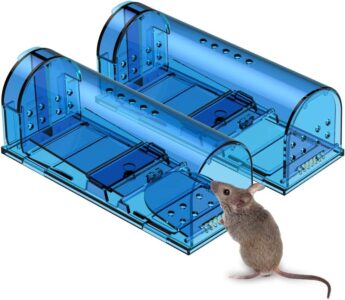Dealing with mice in your home doesn’t always require expensive commercial products or professional exterminators. With a bit of ingenuity and common household items, you can effectively control and eliminate mice using DIY solutions. This comprehensive guide explores practical, budget-friendly home remedies that can help you tackle your mouse problem while keeping your family and pets safe. These solutions not only help to manage the mouse population but also prioritize humane methods for mouse control, ensuring that you can address the problem without unnecessary harm to these creatures. From creating barriers to utilizing natural deterrents, you can find effective ways to keep your home mouse-free. By adopting these approaches, you contribute to a safer and healthier living environment for everyone in your household.
- Why DIY Mouse Control Solutions Work
- Homemade Mouse Traps That Actually Work
- Mouse-Proofing Your Home: Prevention Strategies
- Strategic Deterrent Placement
- Household Items That Deter Mice
- Tracking and Monitoring Mouse Activity
- When to Consider Professional Help
- Frequently Asked Questions
- Conclusion: A Multi-Faceted Approach
Why DIY Mouse Control Solutions Work
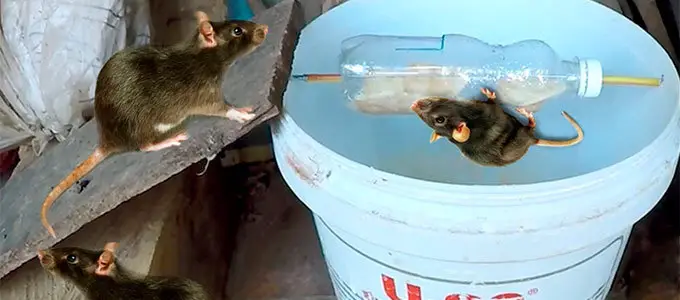
Commercial mouse control products can be expensive, and many contain harsh chemicals that may pose risks to children, pets, and the environment. Homemade solutions offer several advantages:
Cost-Effective
DIY remedies typically utilize items you already have around the house, eliminating the need for expensive specialty products.
Non-Toxic Options
Many homemade solutions use natural ingredients that are safer for your household while still being effective against mice.
Customizable
You can adjust DIY techniques to fit your specific situation, home layout, and severity of infestation.
Immediate Solutions
No waiting for deliveries or store visits – you can implement these remedies right away using materials at hand.
Homemade Mouse Traps That Actually Work
Catching mice doesn’t require expensive store-bought traps. With a bit of creativity and common household items, you can create effective traps that either capture mice alive for release or eliminate them permanently.
The Bucket and Spoon Trap

Materials Needed:
- 5-gallon bucket
- Metal or plastic spoon
- Peanut butter (or other attractive bait)
- Ruler or wooden stick (optional)
How to Set It Up:
- Place the bucket in an area with known mouse activity.
- Scoop a small amount of peanut butter onto the handle end of the spoon.
- Balance the spoon carefully on a counter or table edge with the handle (containing bait) extending over the bucket.
- For a live trap, add about 2-3 inches of water to the bucket bottom – enough to prevent jumping out but not enough to drown the mouse.
- For a more humane live trap with no water, create a one-way slide by propping a ruler or stick against the edge of the bucket at a 45° angle.
Check live trap buckets frequently (at least once daily) to prevent unnecessary stress to captured mice. Release them at least 1 mile from your home in a suitable habitat.
The Glass and Coin Trap

This minimal-effort trap requires just a few household items and works by using a mouse’s own weight against it. It’s perfect for capturing mice alive.
Materials Needed:
- Tall drinking glass or jar
- Coin (quarter or half dollar works best)
- Bait (peanut butter, chocolate, or seeds)
How to Set It Up:
- Place a small amount of bait at the bottom of the glass.
- Carefully balance the glass at a slight angle by propping it up with the coin.
- Position the trap where mice activity has been observed.
- When a mouse enters the glass to retrieve the bait, its weight will cause the glass to fall, trapping it inside.
The glass trap works best on smooth surfaces like countertops or hardwood floors. Carpet or uneven surfaces may prevent the glass from falling properly.
The Milk Bottle Trap
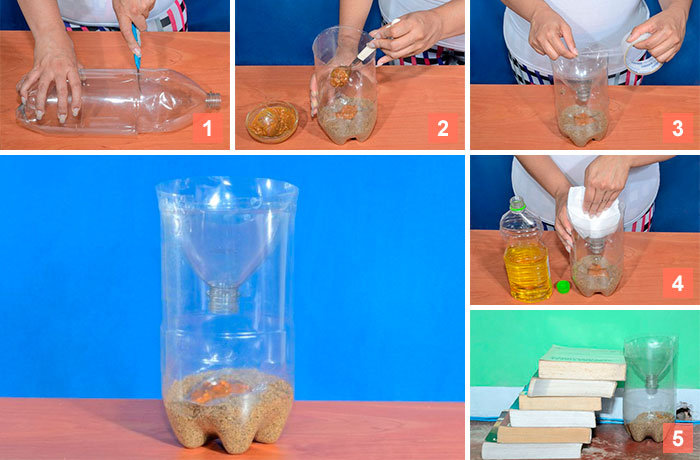
This innovative trap uses a slippery surface to prevent mice from escaping once caught, making it an effective overnight solution.
Materials Needed:
- Empty plastic milk jug or 2-liter bottle
- Cooking oil or petroleum jelly
- Attractive bait (peanut butter, nuts, seeds)
- Bucket
- Wooden ruler or dowel
How to Set It Up:
- Cut the top portion of the bottle to create a funnel shape.
- Apply cooking oil or petroleum jelly around the inside rim and inner walls of the bottle to create a slippery surface.
- Place bait at the bottom of the bottle.
- Create a ramp using a ruler or dowel for mice to climb up.
- Position the bottle over a bucket to prevent escape if knocked over.
For a simpler version, cut a 2-liter bottle horizontally, invert the top half (without cap) into the bottom half, and secure with tape. Place bait in the bottom section. Mice can enter through the funnel but can’t climb back out.
Mouse-Proofing Your Home: Prevention Strategies
The most effective way to deal with mice is to prevent them from entering your home in the first place. These practical steps can help create a mouse-proof environment: Sealing any cracks or gaps in your home’s foundation and walls is essential in keeping mice at bay. Additionally, maintaining a clean space by regularly cleaning up food spills and storing food in airtight containers will deter them from entering. If you find that mice have already made their way inside, learning how to eliminate mice in walls becomes crucial to restoring a safe environment. Sealing any gaps or cracks in walls, doors, and foundations is essential to keep mice out. Additionally, maintaining a clean and clutter-free environment reduces potential nesting sites and food sources. If you’re already facing a mouse problem, seeking expert advice on how to eliminate field mice can provide effective solutions tailored to your situation. Seal any gaps or cracks in walls, doors, and windows to ensure they have no entry points. Additionally, maintaining a clean and clutter-free environment will deter mice and make it easier to spot any signs of their presence. If prevention fails, knowing how to eliminate mice effectively is crucial for maintaining a healthy home.
Always inspect boxes, grocery bags, and packages before bringing them into your home, as mice can hitch rides in these items, especially from warehouses or storage facilities.
Strategic Deterrent Placement
Understanding mouse behavior helps you place deterrents where they’ll be most effective. Focus on these key areas:
Kitchen
Pantries, cabinets, under sinks, behind appliances, and along baseboards.
Garage & Basement
Around water heaters, along wall perimeters, near entry doors, and around stored items.
Living Spaces
Behind furniture, along baseboards, near heating vents, and in rarely disturbed areas.
Bedrooms
Under beds, inside closets, along wall edges, and near bedroom entryways.
Household Items That Deter Mice
Many common household products can be repurposed as effective mouse deterrents without the need for toxic chemicals:
Aluminum Foil

Aluminum foil serves multiple purposes in mouse control. It can be used to:
- Block small entry holes and crevices where mice might enter
- Create physical barriers along countertops and shelves
- Wrap food items to prevent access and contamination
Crumple the foil slightly before placing it in suspected mouse pathways. The irregular surface makes mice uncomfortable and the crinkling sound alerts you to their presence.
Steel Wool and Copper Mesh

These materials are perfect for sealing entry points because mice cannot chew through them:
- Pack holes around pipes with steel wool, then seal with caulk for a permanent solution
- Stuff copper mesh into larger gaps before sealing with expanding foam
- Place behind appliances where cords enter walls
Check your steel wool barriers periodically, as they can rust over time, especially in damp areas like basements or under sinks.
Strategic Fabric Softener Sheets
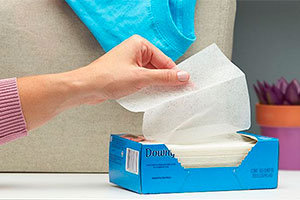
While the scent of fabric softener sheets may not be long-lasting enough to be your only defense, they can supplement other methods:
- Place in drawers and cabinets where food is stored
- Stuff into suspected entry points as a temporary deterrent
- Replace weekly or when the scent fades
Household Spices That Repel Mice
Certain spices from your kitchen cabinet can create natural barriers that mice prefer to avoid:

Cayenne Pepper

Cloves
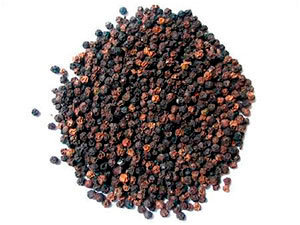
Black Pepper
Application Methods:
- Sprinkle spices generously along baseboards, near entry points, and in mouse-prone areas
- Create pepper sachets using cheesecloth or thin fabric and place in cabinets and drawers
- Mix with water to create a spray for hard-to-reach areas
When using cayenne pepper, avoid creating airborne particles that might cause respiratory irritation. Apply carefully and keep away from children and pets.
Vinegar Solutions
Vinegar’s strong scent makes it an effective temporary deterrent:
- Mix equal parts white vinegar and water in a spray bottle
- Spray around entry points, along baseboards, and in corners
- Refresh application every few days as the scent dissipates
- For stronger deterrent effect, add 10-20 drops of peppermint oil to the solution
Tracking and Monitoring Mouse Activity
To determine if your DIY methods are working, implement these simple tracking techniques:
Flour or Baby Powder Tracking
- Sprinkle a thin layer of flour or baby powder near suspected entry points and along baseboards
- Check for tiny footprints or tail drag marks the next day
- Use this information to place traps and deterrents more effectively
Identifying Active Pathways
- Mice prefer to travel along walls and established pathways
- Look for greasy marks or “rub marks” on baseboards from their fur
- Small, rod-shaped droppings indicate recent activity
- Gnaw marks on food packaging, wood, or wires suggest active mice
When to Consider Professional Help
While DIY methods are effective for minor to moderate mouse problems, there are situations when professional pest control is warranted:
If you see mice during daylight hours, this often indicates a severe infestation, as mice are primarily nocturnal and usually only become visible during the day when their population has grown significantly.
Frequently Asked Questions
How effective are homemade mouse traps compared to commercial ones?
Homemade traps can be just as effective as commercial options when properly constructed and placed. Their success rate depends largely on proper placement along active mouse pathways and using attractive bait. The bucket trap, in particular, can be more effective than single-capture commercial traps because it can catch multiple mice in one night.
The main advantage of DIY traps is cost-effectiveness and immediate availability, while commercial traps may offer more consistent triggering mechanisms. Both require proper placement to be successful.
What is the best bait to use in homemade mouse traps?
Peanut butter is widely considered the most effective bait for mouse traps due to its strong aroma and sticky consistency, which prevents mice from grabbing the food without triggering the trap. Other effective options include chocolate, nuts, seeds, bacon bits, and pet food.
For persistent mice that seem to avoid certain baits, try rotating different foods every few days. Fresh bait typically works better than bait that has been sitting out for days.
How do I clean up after catching mice to prevent disease?
Always wear rubber or latex gloves when handling traps or disposing of mice. Spray the dead mouse and the trap with a disinfectant solution (1 part bleach to 10 parts water) and let sit for 5-10 minutes before disposal. Place everything in a sealed plastic bag, then into an outdoor trash container. After disposing of the mouse and traps, it’s important to clean the area thoroughly to prevent any lingering odors. You can use a mixture of baking soda and water to scrub surfaces where the rodent was found, as this will help neutralize smells. For those struggling with how to remove mouse odors, consider using an enzymatic cleaner specifically designed to eliminate pet and pest-related scents.
Ventilate the area, and clean all surfaces where the trap was placed with the same bleach solution. Never handle mice or their waste with bare hands.
Can I reuse homemade traps after catching a mouse?
Yes, most homemade traps can be reused. Clean thoroughly with a bleach solution (1:10 ratio with water) after each catch, let dry completely, and then reset with fresh bait. For bucket traps, wash with hot soapy water, rinse well, and allow to dry before reusing.
Reusing traps can actually be beneficial, as some research suggests the scent of previously captured mice may attract other mice to the trap.
How long should I keep using repellents after mice seem to be gone?
Continue using repellents for at least 2 weeks after all signs of mouse activity have ceased. Mice are cautious by nature and may temporarily go into hiding when they detect changes in their environment. Maintaining repellents ensures they don’t return once they determine the coast is clear.
For preventative maintenance, refresh repellents in high-risk areas (kitchen, garage, basement) every 1-2 months, especially during fall and winter when mice are more likely to enter homes seeking warmth.
Conclusion: A Multi-Faceted Approach
Successfully controlling mice requires a combination of methods tailored to your specific situation. By utilizing these DIY traps, deterrents, and preventative measures, you can effectively manage mouse problems without breaking the bank or exposing your household to harsh chemicals.
Remember that persistence and consistency are key – mice are adaptable creatures, so you may need to try multiple approaches before finding the most effective solution for your home. By implementing the strategies outlined in this guide, you’ll be well on your way to creating a mouse-free environment.
The best mouse control strategy combines immediate action (trapping) with long-term prevention (sealing entry points and removing attractants). This two-pronged approach not only addresses your current mouse problem but helps ensure they don’t return in the future.
